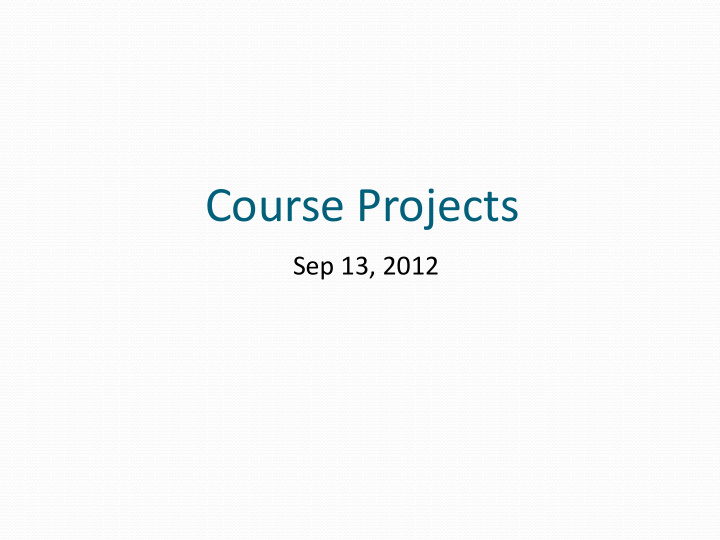



Course Projects Sep 13, 2012
Course Projects Covers 50% of your grade 10-12 weeks of work Required: Serious commitment to project Extra points for working demonstration Project Report Poster presented in poster session Graded by anonymous external reviewers in addition to the course instructors
Project Complexity Depends on what you want to do Complexity of the project will be considered in grading. Projects typically vary from cutting-edge research to reimplementation of existing techniques. Both are fine.
More details Projects will be done in teams of 2 or 3 It is ok to work alone but your project will be no simpler If you cannot find teammates, email the TA Teams will have to spend a lot of time understanding the problem. Team members will also grade each other to make sure that everybody contributes
Incomplete Projects Be realistic about your goals. Incomplete projects can still get a good grade if You can demonstrate that you made progress You can clearly show why the project is infeasible to complete in one semester Remember: You will be graded by peers
Possible projects A list of possible projects will be presented in the rest of this lecture You are also free to pick your own project. Teams must inform us of their choice of project by (mumble,mumble). The later you start, the less time you have to work on the project
Projects from previous years Non-intrusive load monitoring Seam carving Statistical Klatt Parametric Synthesis Voice Transformation using Canonical Correlation analysis Sound source separation and missing feature enhancement Counting blood cells in cerebrospinal fluid And many more …
The Doppler Effect The observed frequency of a moving sound source differs from the emitted frequency when the source and observer are moving relative to each other
The Doppler Effect Spectrogram of horn from speeding car Tells you the velocity Tells you the distance of the car from the mic
Problem Analyze audio from speeding automobiles to detect velocity using the Doppler shift Find the frequency shift and track velocity/position Supervisor: Dr. Rita Singh
Pitch Tracking Frequency shift invariant latent variable analysis Combined with Kalman filtering Estimate the velocity of multiple cars at the same time
More on Doppler Reflections of a 40khz tone from a speaker’s face have Doppler shifts These capture facial movements related to speech They represent articulator movements of the speaker Prior work: Recognizing the speaker from the Doppler measurements Resynthesizing the speech from the Doppler measurements of the speaker’s face
Identifying talking faces Beam ultrasound on talker’s face Capture and analyze reflections Identify subject
Synthesizing Sound from ultrasound observations Doppler reconstruction Original speech Subject mimes sound but does not produce any sound Can we produce sound with just the ultrasound observations?
New Doppler Problem Can we learn to derive articulator information from speech by considering its relationship to Doppler signal Can this be used to improve automatic speech recognition performance Procedure Learn a deep neural network to learn the mapping Use the network as a feature computation module for speech recognition Augments conventional features Supervisor: Bhiksha Raj
Doppler from walking person Gait recognition Beam ultrasound at walking subjects Capture reflections Determine identity of the person
Gesture recognizer Recognizing gestures and the actions that constitute a gesture
Seam Carving
Seam carving for word spotting (Rita Singh) Seams in spectrograms: Word specific Characterize seams to recognize/detect words Combine with traditional methods for improved performance
Song lyric recognition (Rita Singh) Recognize lyrics in songs Conventional Automatic Speech recognition won’t work Stylized voices Overlaid music Mispronunciations Can assume any framework Select lyrics from a collection of lyrics Know words but not lyrics
De-reverberation Develop a supervised technique that can dereverberate a noisy signal Know what is spoken and has prior information about speaker Will work with artificially reverberated data Issues: Modeling the data Learning parameters Overcomplete representations
Sound Classification Identifying cars from their sound Simple problem: Can we build a system that can identify the make (and possibly model) of a car by listening to it? Can you make out the difference between a V6 and a V8 engine? Issues: Gathering training data Modeling
Face Recognition Similar to the face detector, but now we want to recognize the faces too Who was it that walked by my office? Variety of existing techniques available Can be combined with face detection
Recognizing the gender of a face A hard problem Even humans are bad at this
Image Manipulation: Filling in Some images are often occluded Search a database to find objects that best fit into the occluded region
Bonobo ‘speech’ analysis Bonobos and chimpanzees are humans’ closest living relatives Bonobos vocalize in a way similar to humans Need to make sense of several Terabytes of data where bonobos interact with humans Supervisor: Prof. Alan Black
Detecting buses Detecting buses that stand at Forbes and Craig so that you can stay in your office in Gates and work until the bus comes. Need to use the audio or visual data to detect the presence of buses in video. Supervisor: Prof. Alan Black + possibly others
Emotion detection from audio/images Detecting and recognizing the emotion in faces Doing the same from voices
Assigning Semantic tags to video http://www.cs.cmu.edu/~abhinavg/Home.html
Object detection and Clustering Detect various types of objects in images Supervised: You know what objects to detect Unsupervised: Detect objects based on motion
Scene segmentation with audio Identify change of scene with audio alone A set of speakers is scene specific The background conditions change Detect when the change is significant
Scene segmentation with video Automatically detect discontinuity in the narrative with video alone Automatic shot change detection Scene change detection. A scene may have multiple shots
Some more ideas will be put on the website
Questions?
Recommend
More recommend